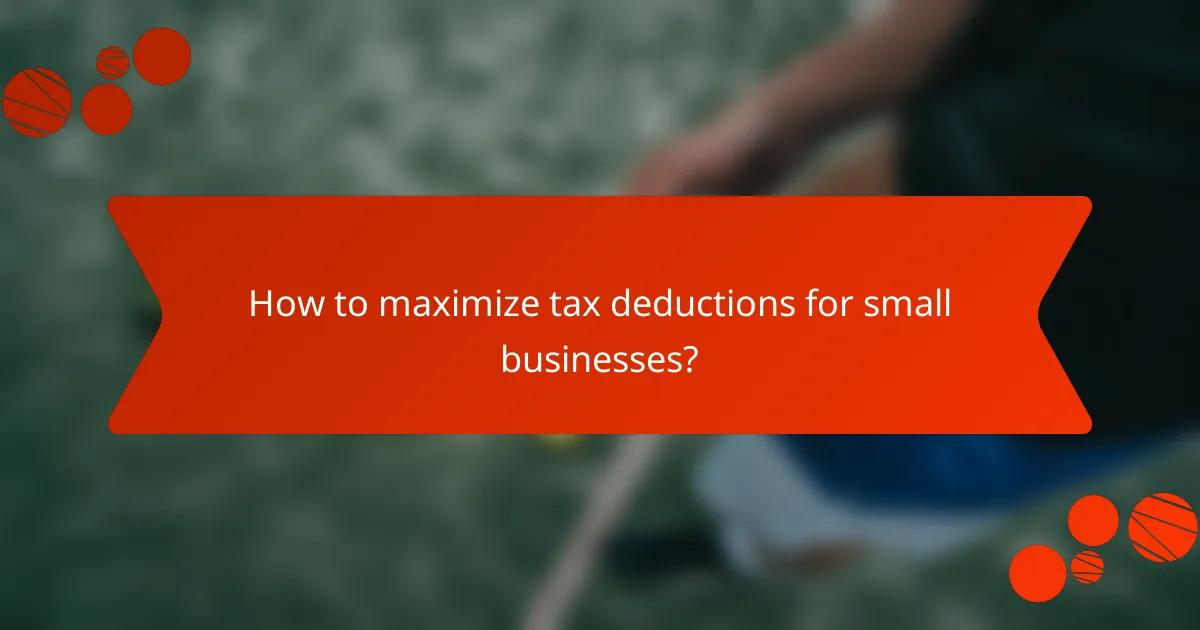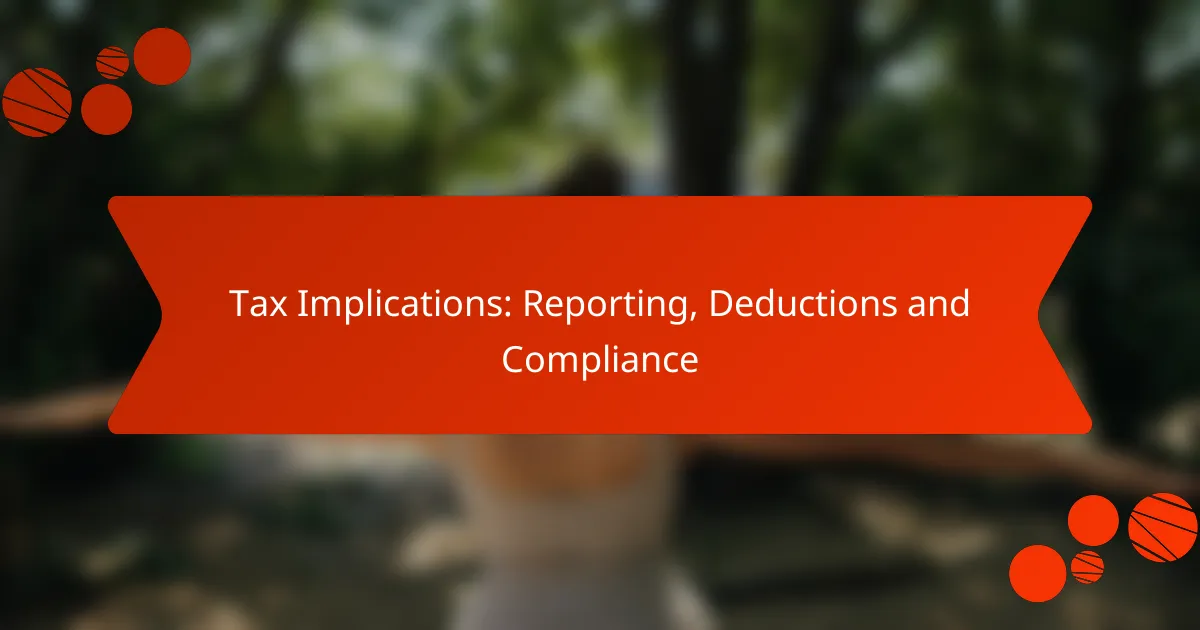Understanding tax implications is crucial for individuals and businesses alike, as it encompasses reporting requirements, deductions, and compliance obligations. Different entities, such as individuals, partnerships, and corporations, must navigate specific forms and deadlines to ensure accurate reporting. Additionally, small businesses and freelancers can benefit from knowing which expenses are deductible to minimize taxable income while avoiding potential penalties for non-compliance.

What are the tax reporting requirements in the United States?
In the United States, tax reporting requirements vary based on the type of entity and income level. Individual taxpayers, partnerships, corporations, and nonprofits each have specific forms and deadlines to adhere to for accurate reporting and compliance.
Form 1040 for individual taxpayers
Form 1040 is the standard tax form used by individual taxpayers to report their annual income. This form requires details about income sources, deductions, and credits, allowing taxpayers to calculate their tax liability or refund.
Taxpayers must file Form 1040 by April 15 each year, although extensions may be available. Common deductions include those for mortgage interest, student loans, and charitable contributions, which can significantly reduce taxable income.
Form 1065 for partnerships
Form 1065 is used by partnerships to report income, deductions, gains, and losses from the partnership’s operations. Unlike corporations, partnerships do not pay income tax at the entity level; instead, income is passed through to partners who report it on their individual returns.
Partnerships must file Form 1065 by March 15, with each partner receiving a Schedule K-1 detailing their share of the income. Accurate reporting is crucial to avoid penalties and ensure that partners correctly report their income.
Form 1120 for corporations
Form 1120 is the tax return filed by C corporations to report their income, gains, losses, deductions, and credits. Corporations are taxed separately from their owners, which can lead to double taxation on dividends distributed to shareholders.
Corporations must file Form 1120 by the 15th day of the fourth month after the end of their tax year. Understanding corporate deductions, such as business expenses and depreciation, is essential for minimizing tax liability.
Form 990 for nonprofits
Form 990 is required for tax-exempt organizations to provide the IRS with information about their activities, governance, and financials. This form ensures transparency and accountability, helping the public understand how nonprofits operate and utilize their funds.
Nonprofits must file Form 990 annually, typically by the 15th day of the fifth month after the end of their fiscal year. Accurate reporting is vital for maintaining tax-exempt status and building trust with donors and stakeholders.

How to maximize tax deductions for small businesses?
To maximize tax deductions for small businesses, it’s essential to understand which expenses are deductible and how to properly document them. By strategically managing expenses and utilizing available deductions, businesses can significantly reduce their taxable income.
Deductible business expenses
Deductible business expenses are costs that are necessary and ordinary for running a business. Common examples include rent, utilities, salaries, and supplies. Keeping accurate records of these expenses is crucial for substantiating deductions during tax filing.
To ensure you capture all deductible expenses, maintain organized receipts and invoices. Consider using accounting software to track expenditures throughout the year, which can simplify the deduction process when tax season arrives.
Home office deduction criteria
The home office deduction allows small business owners to deduct expenses related to the portion of their home used exclusively for business. To qualify, the space must be used regularly and exclusively for business activities, such as meetings or administrative tasks.
Eligible expenses can include a portion of rent or mortgage interest, utilities, and home maintenance costs. Calculate the deduction based on the square footage of the home office compared to the total home size, ensuring you meet the IRS requirements for this deduction.
Section 179 for equipment purchases
Section 179 allows small businesses to deduct the full purchase price of qualifying equipment and software in the year it is purchased, rather than depreciating it over several years. This can significantly reduce taxable income and improve cash flow.
For the tax year 2023, businesses can deduct up to $1,160,000 for qualifying equipment, with a phase-out threshold starting at $2,890,000. It’s essential to ensure that the equipment is used more than 50% for business purposes to qualify for this deduction.

What are the compliance risks for freelancers?
Freelancers face several compliance risks, primarily related to tax obligations and reporting requirements. Failing to meet these obligations can lead to penalties, interest charges, and potential audits from tax authorities.
Estimated tax payments
Freelancers are generally required to make estimated tax payments throughout the year, as they do not have taxes withheld from their income. These payments are typically due quarterly and are based on expected annual income. Missing these deadlines can result in penalties, so it’s crucial to calculate and pay the correct amounts on time.
A common approach is to estimate your tax liability based on previous years’ income or to use the IRS Form 1040-ES for guidance. Many freelancers find it helpful to set aside a percentage of each payment they receive, often around 25-30%, to cover their tax obligations.
Self-employment tax obligations
Self-employment tax is a significant consideration for freelancers, as it covers Social Security and Medicare taxes. This tax is applicable to net earnings above a certain threshold, and freelancers must calculate it separately from their income tax. The self-employment tax rate is currently around 15.3% on net earnings.
Freelancers should be aware that they can deduct the employer-equivalent portion of self-employment tax when calculating their adjusted gross income, which can help reduce overall tax liability. Keeping accurate records of income and expenses is essential to ensure compliance and minimize tax burdens.

How to choose a tax professional?
Choosing a tax professional involves assessing their qualifications, experience, and the specific services you need. Look for someone who understands your financial situation and can navigate the complexities of tax regulations effectively.
Certified Public Accountant (CPA) benefits
CPAs are licensed professionals who have passed rigorous examinations and meet ongoing education requirements. They can provide a wide range of services, including tax preparation, financial planning, and auditing, making them versatile for various financial needs.
One key advantage of hiring a CPA is their ability to represent clients in front of the IRS, which can be crucial if you face an audit or need to resolve tax disputes. Their expertise can help minimize your tax liability and ensure compliance with current tax laws.
Enrolled Agent (EA) advantages
EAs are tax professionals who have passed a comprehensive examination administered by the IRS or have experience as former IRS employees. They specialize in tax matters and can represent taxpayers before the IRS, similar to CPAs.
One benefit of working with an EA is their deep understanding of tax codes and regulations, which can be particularly useful for complex tax situations. EAs often have lower fees compared to CPAs, making them a cost-effective option for individuals and small businesses.

What are the implications of the Tax Cuts and Jobs Act?
The Tax Cuts and Jobs Act (TCJA) significantly altered the tax landscape for individuals and businesses in the United States. Key changes include reduced tax rates, modifications to deductions, and new compliance requirements that taxpayers must navigate.
Changes to individual tax rates
The TCJA lowered individual tax rates across several income brackets, making it generally more favorable for taxpayers. For example, the top tax rate was reduced from 39.6% to 37%, impacting high earners significantly.
Additionally, the standard deduction nearly doubled, which means many taxpayers will benefit from a lower taxable income. For 2023, the standard deduction is approximately $13,850 for single filers and $27,700 for married couples filing jointly.
Impact on business deductions
The TCJA introduced changes that expanded certain business deductions while limiting others. For instance, businesses can now deduct 100% of the cost of qualified property in the year it is placed in service through bonus depreciation.
However, some deductions were capped or eliminated, such as the limitation on the deductibility of interest expenses for larger businesses. Companies should carefully assess their eligibility for deductions to maximize tax benefits while ensuring compliance with the new regulations.

How to stay updated on tax law changes?
To stay updated on tax law changes, regularly check reliable sources and subscribe to relevant updates. This ensures you are informed about new regulations, deadlines, and compliance requirements that may affect your tax situation.
IRS website resources
The IRS website is a primary source for accurate and up-to-date tax information. It offers a variety of resources, including news releases, tax law updates, and publications that explain changes in detail.
Utilizing the IRS’s online tools can help you understand how new laws impact your filings. For example, the Interactive Tax Assistant can answer specific questions about your tax situation based on the latest regulations.
Tax news subscriptions
Subscribing to tax news services can provide timely updates on changes in tax legislation. Many reputable financial news outlets offer newsletters or alerts focused on tax issues, which can be invaluable for staying informed.
Consider subscribing to services like Tax Notes or the Journal of Accountancy, which provide in-depth analysis and commentary. These resources often highlight practical implications and deadlines, helping you prepare effectively for tax season.



